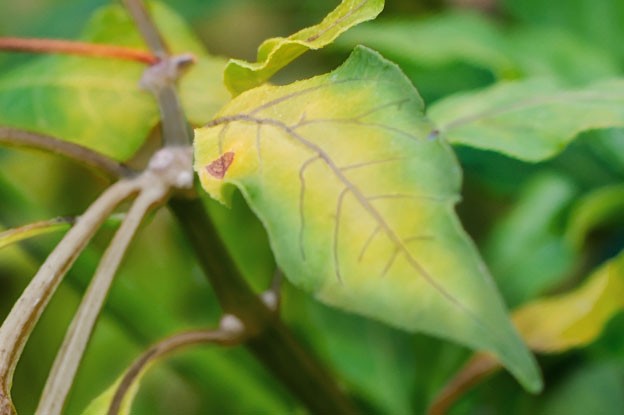Sulphur deficiency
Sulphur deficiency resembles nitrogen deficiency, but at the top of the plant. Because sulphur is not mobile, the deficiency is first observed in the younger leaves. These turn pale green, while the petioles get a strong purple tint. The leaf tips can curl up. If several leaves start to fade, the colour changes from light green to deep yellow. In case of a serious deficiency, flowering and growth are inhibited. A lack of sulphur can lead to a lower yield and poor quality of the end product.

How do you recognise a sulphur deficiency?
Greening of the younger leaves.
Leaf stems get a purple tint.
The veins will start yellowing.
Leaf tips may curl up.
In case of serious deficiency flowering and growth are inhibited.
What is the (possible) cause?
The pH level of the soil or substrate is too high.
Incorrect composition of nutrients.
How can you prevent it?
A sulphur deficiency only tends to occur when growing in potting soil. Even a small shortage can have a major influence on the yield of your crop. We recommend using one of our base nutrients (like Hydro A&B) to reduce the likelihood of a deficiency. Also keep abiotic factors in mind. These include temperature, light intensity, acidity, amount of moisture and wind strength.
How can you cure it?
You can add extra sulphur by means of additional fertilisation. Another option is to lower the pH value of your soil or substrate. This can be done by rinsing your system with clean, pH-controlled water.
What does sulphur do for the plant?
Sulphur, along with nitrogen, is very important for the production of amino acids. These amino acids are used in proteins. As sulphate, sulphur is also important for the water balance of the plant. Additionally, sulphur is active in the structure and metabolism of the plant and accelerates the production of chlorophyll. These help your plant grow through photosynthesis.
Not sure if you have a sulphur deficiency?
Contact our Grow Expert via Servicedesk and ask for advice.